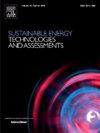带峰谷散热器的海上直驱永磁同步发电机的热分析
IF 7
2区 工程技术
Q1 ENERGY & FUELS
Sustainable Energy Technologies and Assessments
Pub Date : 2025-06-20
DOI:10.1016/j.seta.2025.104365
引用次数: 0
摘要
针对具有对角轴向通风结构(DA-VS)的大型海上风力发电机的发热问题,以额定功率为5MW的海上内转子永磁风力发电机(OIR-PMWG)为研究对象。首先,基于流体力学和传热学的基本理论,建立了具有对角轴向通风结构的海上内转子永磁风力发电机(OIR-PMWG)流热耦合的三维物理数学模型,并采用有限体积法进行了求解。为了提高海上风力发电机的热性能,本文提出了PartB和PartC两种峰谷交变散热器结构。研究了峰谷交替散热方案对发电机翅片间流体速度分布和重要部件温升的影响。其中,PartC方案可使翅片之间的流体速度提高11.5%,使缠绕温度降低9.6℃。本文提出的峰谷交替散热器方案可以重新分配散热器之间的流量和风速,提高通风系统的效率,为海上风力发电机组通风冷却结构的设计提供参考。本文章由计算机程序翻译,如有差异,请以英文原文为准。

Thermal analysis of direct-drive offshore permanent magnet synchronous generator with peak–valley heat sinks
Aiming at the heat generating problems of high-scale offshore wind generator with diagonal-axial ventilation structure (DA-VS), an offshore inner rotor permanent magnet wind generator (OIR-PMWG) with a 5MW rated power is taken as the research object. Firstly, based on the basic theories of fluid dynamics and heat transfer, a three-dimensional physical and mathematical model of fluid–heat-coupled for offshore inner rotor permanent magnet wind generator (OIR-PMWG) with diagonal-axial ventilating structure is established which is solved by the finite volume method. In this paper, in order to improve the thermal performance of offshore wind generator, two alternating peak–valley heat sink structures, PartB and PartC, are proposed. The effects of the alternating peak–valley heat sink schemes on the velocity distribution of the fluid between the fins and the temperature rise of the important generator’s parts are investigated. Among them, the PartC scheme is able to increase the fluid velocity between the fins by 11.5% and reduce the winding temperature by 9.6 °C. The alternating peak–valley heat sink schemes proposed in this paper can redistribute the flow rate and air velocity between the heat sink, improve the efficiency of the ventilation system, and provide a reference for the design of ventilation and cooling structures for offshore wind generator.
求助全文
通过发布文献求助,成功后即可免费获取论文全文。
去求助
来源期刊

Sustainable Energy Technologies and Assessments
Energy-Renewable Energy, Sustainability and the Environment
CiteScore
12.70
自引率
12.50%
发文量
1091
期刊介绍:
Encouraging a transition to a sustainable energy future is imperative for our world. Technologies that enable this shift in various sectors like transportation, heating, and power systems are of utmost importance. Sustainable Energy Technologies and Assessments welcomes papers focusing on a range of aspects and levels of technological advancements in energy generation and utilization. The aim is to reduce the negative environmental impact associated with energy production and consumption, spanning from laboratory experiments to real-world applications in the commercial sector.
 求助内容:
求助内容: 应助结果提醒方式:
应助结果提醒方式:


